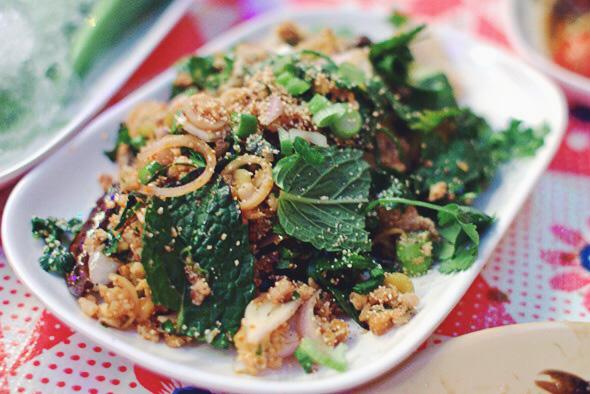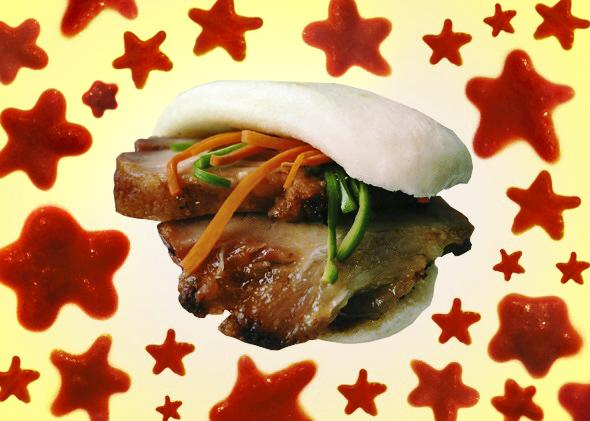Pork belly steam buns. Snapping turtle soup. Clam pizza with Thai chilies. These dishes might not seem to have much in common with one another, but in fact, they’ve all been classified as belonging to the same cuisine: New American. Loosely defined as farm-to-table fusion food with French and Asian influences, New American cuisine can now include just about any ingredient or technique from around the world. In theory, that reflects our country’s melting-pot culture and gives chefs freedom to play. But in practice, New American restaurants have become bland and derivative, little more than watered-down steakhouses with exotic words like yuzu and gremolata thrown onto the menus for good measure.
Though the New American movement has roots in 1960s French nouvelle cuisine, it began in earnest a few decades later, when chefs like Alice Waters in Berkeley, California, and Larry Forgione in New York started to emphasize fresh, local ingredients and draw from global influences. Food historians can’t nail down the exact origin of the term, but by 1981 Apartment Life magazine (later Metropolitan Home) had published a book called The New American Cuisine, and by the late 1980s, chef Jeremiah Tower’s book New American Classics had become a restaurant kitchen bible.
These French-trained chefs “embraced many of the tenets of nouvelle cuisine but interpreted them in their own ways,” with the aim of changing our idea of an upscale restaurant experience, said historian Alexandra Leaf. “We brought a European sensibility to the U.S., and then we regionalized it and made it our own,” said Rozanne Gold, one of the chefs who pioneered the New American food movement. The New York Times’ 1999 review of Forgione’s influential American Place restaurant summarized the gist of this new cuisine well: “Spring rolls are indisputably Asian, but when they’re stuffed with Dungeness crab from Washington State and served with a smoked onion remoulade and Charleston vegetable slaw, it’s pretty clear that the culinary melting pot has absorbed yet another immigrant.”
But as years have passed, the concept has become watered down. Gold said, “Once a sparkplug for American creativity, New American has become a meaningless term.” Chef Charlie Palmer told Zagat, “The definition has become a bit broad and unclear. … [M]any chefs use ‘New American’ to allow them to include whatever they like on their menu without being restricted to a certain cuisine or specific technique.” That can translate into brilliant dishes, but it also means that if a restaurant doesn’t neatly fit into a category like “Italian,” “Chinese,” or “Indian” but uses flavors from all three, for example, it’s thrust into that cast-iron pot of “New American.” Even chef Thomas Keller is confused by the term, facetiously asking me recently what new food even means.

Photo by Krista/Flickr Creative Commons
In practice, New American cuisine relies largely on already-charted French, Italian, and Asian ingredients and techniques. But in order to appeal to the lowest common denominator, chefs end up watering down the strong flavors from those cuisines. Thai food, for example, layers funky, weird ingredients to create spicy, salty, sweet, sour, bitter, umami flavors that will make you an addict for life. (Just try Andy Ricker’s homages to Thailand at Pok Pok to see for yourself.) But on a New American menu, you’ll never see fish sauce combined with chilies, sugar, shrimp paste, kaffir lime, and shallots. Rather, chefs opt to use singular ingredients that don’t do much on their own. Add one dot of sriracha on the side of a plate of shrimp and grits, and you don’t get anywhere near the impact of real Thai food.
Another problem with New American cuisine is that it’s prone to faddishness. Instead of taking advantage of the possibilities allowed by such an expansive cuisine, New American chefs copycat the few chefs who are actually innovating. Gold said, “If you analyze current restaurant menus, there’s an astonishing sameness.” Ingredients and dishes pop up on menu after menu as New American chefs follow trends: Dashi broth. Fried Brussels sprouts. Foie gras peanut butter and jelly.
Keller told me that being an American chef ought to mean that there are “more opportunities, because we’re not tied to ethnic or culture cuisines like the French or Japanese.” Corey Lee from Benu added that being American “gives us liberty as chefs.” So why do we settle for New American cuisine that is so often bland and derivative?
Americans deserve better. This is a call for chefs to create a distinctly new American cuisine that doesn’t rely on tradition but is accessible and delicious. What would this type of food look like? It would be creative and bold in both flavor and technique.
This new cuisine would innovate with new but practical techniques or turn traditional ideas about dishes on their heads. Americans have long been innovating this way: For example, Leaf said that back in the 19th century, pioneer women invented a new type of cake by measuring ingredients with coffee or tea cups and then baking the batter in those cups, creating the first cupcakes. This kind of inventiveness is not always motivated by necessity—sometimes, it’s motivated by sheer creativity. These days, torchbearing chefs like David Chang, Danny Bowien, and Rich Torrisi innovate by drawing not on Old World influences but on distinctly American iterations of “ethnic” food to make fusion cuisine with bold flavors and a sense of humor, unlike most New American food.

Photos by J. Potter-Miller/Cherrywood Neighborhood Association/Flickr Creative Commons
New new American food would also use ingredients from North America, the way René Redzepi uses produce native to Denmark. I’m not talking about a pizza topped with ramps. Rather, we need to find ways to use North American ingredients that create a new dish or type of food. Some restaurants already innovate this way. Wood from mesquite trees has long been used to smoke meat in the South, and recently chefs have started to use the plant differently, drying, toasting, and grinding the pods to create a slightly sweet, distinct spice for desserts. For instance, at Dai Due, an Austin, Texas–based restaurant that sources 100 percent of its ingredients locally, pastry chef Abby Love uses mesquite powder with whole wheat to make graham crackers for her loquat ice cream sandwich.
There’s one other ingredient that belongs in a truly American cuisine: individualism. You may have eaten clam chowder, but “the second you say let’s go to Andrew Carmellini’s restaurant and eat his chowder, that’s modern food,” Lee said. “You’re seeing a dish through the lens of a particular person.” Carmellini reworks traditional chowder by cooking potatoes in milk and cream separately and replacing clams with smoked whitefish for a deep, strong flavor that’s a testament to his distinct creativity. Like Carmellini, New American chefs need to express their unique identities through their food rather than kowtow to customary recipes or hitch their wagons to dishes that other chefs have already perfected.
In 1893 Frederick Jackson Turner theorized that the expanding frontier built American identity by releasing us from European constraints and customs. With his “Frontier Thesis,” Turner argued that the adventure of the West created a uniquely American personality: “that coarseness and strength combined with acuteness and acquisitiveness; that practical inventive turn of mind, quick to find expedients; that masterful grasp of material things … that restless, nervous energy; that dominant individualism.” If chefs take Turner’s words to heart, they can make New American food, well, American again.
